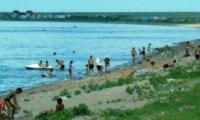You are here
Flora and fauna of Lake Shalkar.

A trip to Lake Shalkar in the West Kazakhstan region.
"And the lake in a quiet evening fire
Lying in the depths, still shining,
And the pines, like candles, stand above
Closing in rows from edge to edge.
A bottomless bowl of clear water
Beamed and thought with a separate thought,
So the eye of the patient in longing infinite
At the first radiance of an evening star,
No longer sympathizing with the patient’s body,
Burning, directed to the night sky.
And crowds of animals and wild animals
Putting horned faces through the trees
To the source of truth, to his font
Bowed life-giving water to get drunk"
Forest Lake. Nikolai Zabolotsky. 1938.
Rest on the lake Shalkar in the West Kazakhstan region.
South of the large village of Chapaev, the Solyanka River flows into the wide Ural Bay. True, this river can only be called a tributary conditionally. In summer, it completely dries up, and in the high spring water the Urals turns it back.
The Solyanka River was created by nature for excess water from Lake Shalkar, located 30 km east of the Urals. Lake Shalkar, or the steppe sea, as the Ural Cossacks called it, occupies an extensive hollow in the center of the salt massif.
The lake is sandwiched from the north and south by two pointed mountains of Santae and Sasai, which are raised sides of the salt dome. In order to better see the steppe sea, we will climb Mount Sasai, which rises above its southern coast by almost 80 meters above sea level.
The top of this mountain, inclined to the south, has a height of 94 meters above sea level. At its base, the mountain is composed of a powerful salt stratum of Kungur age. On the western slope of the mountain there are sandstone outlets.
In its vicinity, numerous round-shaped karst funnels filled with water are scattered. The slopes of the mountain are well sod. Light chestnut soils with spots of solonchaks are combined in the soil cover. The vegetation cover of the soles, slopes and peaks of the mountain is steppe with a change in associations from wormwood on the top of the mountain.
Botanists on Mount Sasai discovered 238 plant species belonging to 40 families. From the top of the mountain, Lake Shalkar is well viewed, occupying a circular hollow 18 km long and 15 km wide. The shoreline of the lake is 50 km, an area of about 210 square kilometers.
The average depth of Shalkar is 7 meters, the greatest - 12 meters. About 1.4 kilometers of cubic water accumulate in the Shalkar basin, which is collected by the Bolshaya Ankata rivers (length 130 km) and Malaya Ankata (73 km) with an area of 3,740 square kilometers.
No wonder Shalkar is called the sea: strong steppe winds often raise high waves here, crashing ashore with noise. The shallow waters of the lake are buried in reed and cattail thickets, where many of its inhabitants take refuge: swans, geese, various species of ducks.
On the shallows are white and gray herons. Flocks of seagulls with simple screams accompany each uninvited guest. Pink flamingos fly on Shalkar. Curly pelicans arrive to feast on fish. The lake is famous, first of all, for carp, bream and pike perch, which are fished here by the Ural fish factory.
Shalkar is the largest inland water body in the Ural basin, and it is located at one of the most important landscape crossroads in the region. To the north of the lake are feather-grass fescue steppes, on the south side semi-desert landscape lands approach it.
The Shalkar salt dome is located on the border of the Caspian Depression and the Podural Cretaceous Plateau - Mount Santae on the northern coast and other chalk slides in the upper Bolshoi and Malaya Ankata can be considered its leading and sentinel.
And the lake-sea itself brings a certain uniqueness to the nature of the landscape crossroads of the Northern Caspian. All this makes the area of Lake Shalkar extremely interesting for scientific and educational purposes and tourism.
Authority:
A.A. Chibilev. "The Ural River." Leningrad. Hydrometeoizdat, 1987.
Photo
Alexander Petrov.







